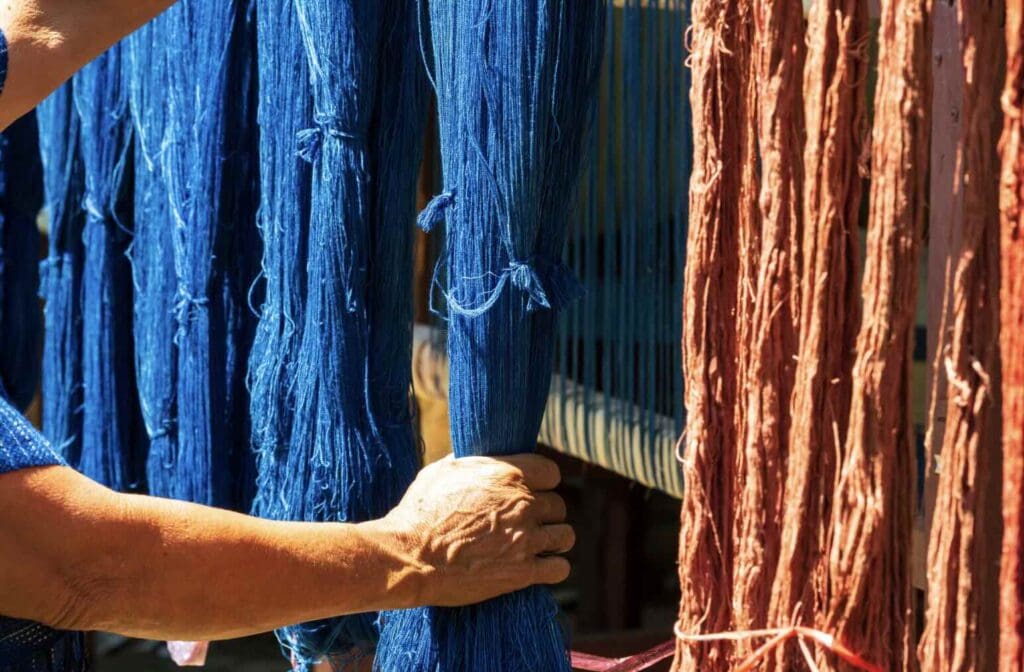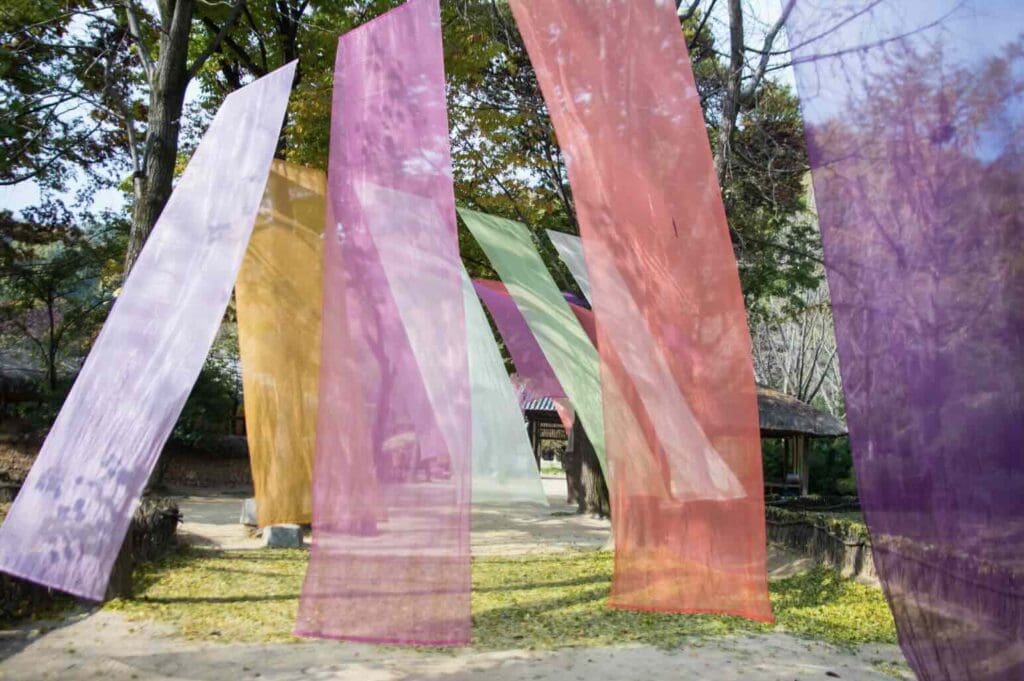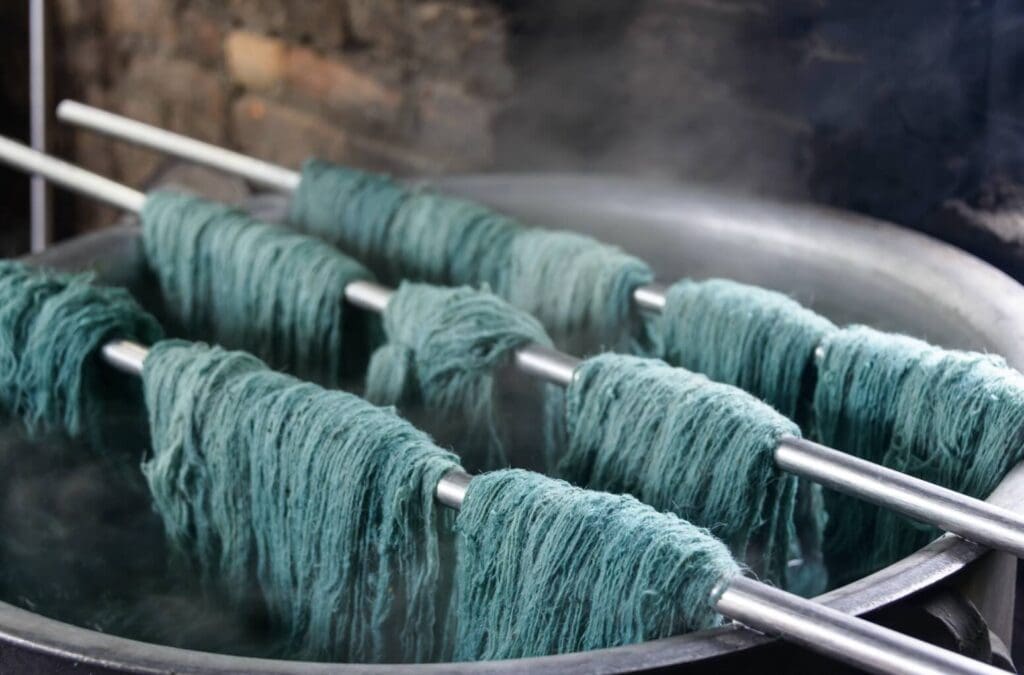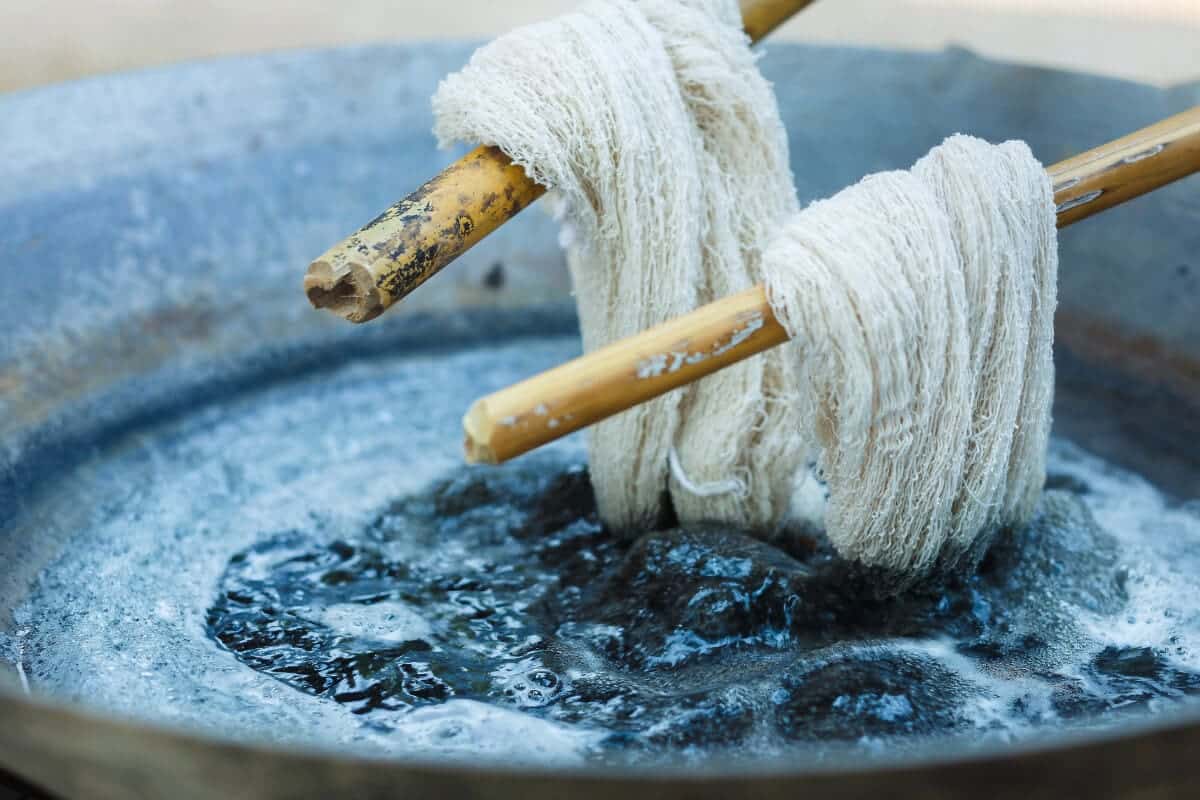In the ever-evolving world of fabric dyeing, natural dyes are stepping back into the limelight, carving a path that is both old and new. As we look closer, the allure of these colors, drawn directly from nature’s palette, seems to be more than just about beauty.
They bring with them a promise for a healthier planet and a nod to ancient traditions. This exploration will shed light on the significant advantages and unique charm of using natural dyes in fabric dyeing, revealing why they are increasingly becoming the choice for those seeking sustainability and uniqueness.
Table of Contents
- Understanding Natural Dyes
- The Process of Natural Dyeing
- Challenges and Solutions in Natural Dyeing
- Related Content
Understanding Natural Dyes
What Makes Natural Dyes a Preferred Choice for Fabric Dyeing?
The spotlight is increasingly shining on natural dyes in the vast world of fabric dyeing. This method isn’t new; it dates back to ancient times when all dyes came from the earth. However, amidst the modern clamor for sustainability and eco-friendliness, natural dyes are experiencing a renaissance. They offer many benefits over their synthetic counterparts, from being better for the environment to adding unique aesthetic qualities to fabrics. Here’s an exploration of why natural dyes are a top choice for fabric dyeing.
Natural dyes are derived from nature’s treasures—plants, minerals, and sometimes even insects. These sources provide a rich palette of colors grounded in the environment’s very essence. Unlike synthetic dyes, which are concocted from chemicals, natural dyes carry the subtle, complex shades of the natural world into the fabric they dye.
One of the most compelling reasons to choose natural dyes is their environmental impact. Synthetic dyes often involve toxic chemicals in their production and the dyeing process, leading to water pollution and harm to aquatic life when waste is improperly disposed of. Natural dyes, on the other hand, are biodegradable and, when used responsibly, minimize harm to the ecosystem. This makes them a cornerstone in pursuing sustainable fashion and textile production.
Furthermore, natural dyes are kinder to our skin. The harsh chemicals in synthetic dyes can trigger allergic reactions or skin irritations in sensitive individuals. Natural dyes, with their organic origins, are generally gentler. This does not mean they are entirely free from causing reactions, but the risk is notably less, making naturally dyed fabrics a safer choice for direct skin contact.
Another area where these dyes shine is the aesthetics of fabric dyed with natural substances. The colors achieved with natural dyes possess a depth and variance that synthetic dyes often lack. Each batch can bring slight variations, adding character and uniqueness to the fabric. This is especially valued in handmade or artisanal textiles, where the beauty lies in the uniqueness of each piece.
Moreover, natural dyes foster a connection with traditional techniques and cultural heritage. Many communities around the world have dyeing techniques that have been passed down through generations, encapsulating history and identity. Craft craftsmen and consumers partake in this rich tapestry by choosing natural dyes and preserving and appreciating these age-old practices.
The increased interest in natural dyes also promotes biodiversity. As the demand for naturally dyed fabrics grows, so does the need for the plants and materials used in creating these dyes. This can encourage the cultivation of dye plants, contributing to agricultural diversity and preserving overlooked species.
Choosing natural dyes for fabric dyeing is not without its challenges. The colors can be more variable and sometimes less vibrant than synthetic alternatives. Additionally, natural dyes often require more knowledge and skill to use effectively.
However, the benefits they offer—environmental friendliness, health safety, unique aesthetics, cultural connection, and support of biodiversity—make them a preferred choice for many in the fabric dyeing industry. As we move towards more sustainable practices, the role of natural dyes becomes increasingly significant, highlighting their importance not just in textiles but in the broader context of ecological and cultural preservation.

The Process of Natural Dyeing
Dyeing fabric naturally involves a process that is as rich in history as in color. This ancient art, while straightforward in concept, requires patience, precision, and creativity. Let’s explore how to transform your fabrics with the hues of nature, from preparation to finishing.
Step 1: Choosing Your Fabric
Natural fibers like cotton, silk, wool, and linen are best taken with natural dyes. Before you begin, ensure your fabric is pre-washed to remove any residues that might interfere with dye absorption.
Step 2: Preparing the Fabric
You’ll need a mordant to help the fabric absorb the dye more effectively. A mordant is a substance that binds the dye to the fabric, ensuring the color stays vibrant through washes. Common natural mordants include alum and tannin. The choice of mordant can affect the final color, so pick accordingly. Soak your fabric in the acidic solution following specific instructions for the mordant you’re using.
Step 3: Making the Dye
Natural dyes can be extracted from various sources, including leaves, roots, bark, berries, and even insects. The first step is to chop your chosen material into small pieces to increase the surface area. Then, simmer the materials in a large pot of water for an hour or more until the water absorbs the color. The exact time depends on the material used. Strain the solids from the liquid, and your dye is ready.
Step 4: Dyeing the Fabric
Wet your pre-mordanted fabric in warm water so it’s damp but not dripping. Add it to the dye bath, ensuring it’s completely submerged. Simmer the fabric in the dye bath, stirring gently but frequently to ensure even color absorption. This could take anywhere from an hour to several, depending on the desired intensity of the color. Remember, the fabric will look darker when wet and lighten somewhat after drying.
Step 5: Checking the Color
Carefully remove a small section of the fabric from the dye bath to check the color. Remember that the final shade will be lighter once the fabric dries. You can move on to the next step if the color meets your expectations. If not, continue simmering and checking periodically.
Step 6: Rinsing
Once you achieve the desired shade, remove the fabric from the dye bath. Rinse it under cold running water to remove excess dye until it is clear. This step is crucial to ensure the fabric doesn’t bleed color later.
Step 7: Drying and Setting the Color
Gently squeeze (don’t wring) the fabric to remove excess water, and hang it to dry away from direct sunlight to prevent fading. Once dry, iron the fabric to help set the color. Setting the color is essential in preserving the vibrancy of your naturally dyed fabric.
By following these steps, you not only imbue your fabric with beautiful, natural colors but also engage in an eco-friendly, sustainable practice that is gentle on the skin and the environment. Whether you’re a seasoned dyer or a newcomer to the craft, natural dyeing opens up a world of creative possibilities, allowing you to connect with traditions while crafting something truly unique.

Challenges and Solutions in Natural Dyeing
Natural fabric dyeing, rich with benefits and steeped in tradition, presents challenges that can sometimes deter artisans and manufacturers. Understanding these obstacles and identifying ways to overcome them is crucial for anyone looking to delve into or continue with natural fabric dyeing.
Consistency and Reproducibility
One of the main hurdles in natural fabric dyeing is achieving color consistency. The color yield from natural sources can vary significantly due to factors like soil composition, weather conditions, and even the specific part of the plant used. This variability makes reproducing the same color in different dye batches challenging.
Solution: To mitigate this issue, meticulous record-keeping is essential. Keeping detailed notes on the source, type, and even the harvest date of dye materials can help. Blending dyes from different batches before dyeing can also create a more uniform color batch.
Colorfastness
Natural dyes tend to have a reputation for fading more quickly than synthetic ones. Exposure to sunlight and repeated washing can lead to significant color loss over time.
Solution: Addressing this concern starts with the mordanting process, which helps fix the dye to the fabric. Using natural mordants like alum and tannin not only improves colorfastness but does so in an environmentally friendly manner. Additionally, educating end-users on caring for naturally dyed fabrics—such as washing in cold water and avoiding direct sunlight—can prolong the life of the colors.
Limited Color Palette
Natural dyes offer a beautiful spectrum of colors, but some shades, such as exceptionally bright blues, greens, and vibrant purples, are notoriously difficult to achieve. This can limit the color palette available for natural fabric dyeing projects.
Solution: Experimentation and research are essential. For instance, a green shade can be achieved by dyeing the fabric yellow and then over-dyeing it with a blue. Networking with other dyers and participating in workshops can open doors to new techniques and recipes for elusive colors. Furthermore, embracing the limitations of natural colors can lead to unique and beautiful textile art that stands out due to its natural charm.
Time and Labor Intensity
Natural dyeing is a time-consuming process. Each step requires patience and care, from harvesting and preparing the dyes to the dyeing and setting processes. This can be a significant challenge, especially in a commercial context where time equals money.
Solution: Streamlining the dyeing process without sacrificing the quality of the end product involves planning and organization. Batching tasks, such as preparing large quantities of dye in advance and dyeing multiple fabrics at once, can improve efficiency. Emphasizing the unique qualities of naturally dyed fabrics can also justify the higher price point and longer production time to consumers who value sustainability and craftsmanship.
Cost
Lastly, the cost of natural dyeing can be higher than that of synthetic alternatives. Collecting natural materials and the more labor-intensive processes can add to the overall expense.
Solution: Cultivating a market that appreciates and is willing to pay for the added value of naturally dyed products is essential. Artisans can also look into locally sourcing dye materials or growing their own to reduce costs. Waste materials from other industries (like onion skins or avocado pits) can also serve as economical and sustainable dye sources.

Understanding the complexities, challenges, and immense rewards of working with natural dyes makes it clear that these methods offer more than just a splash of color to our fabrics.
They stitch together a tale of environmental consciousness, health considerations, and cultural depth, enriching more than just our wardrobes. As such, embracing natural dyes is not merely a choice but a profound statement favoring ecological balance, personal well-being, and aesthetic diversity. It is a step towards rekindling our bond with the natural world and rediscovering the artistry of our ancestors, making the fabric of our lives more prosperous and meaningful.
If you are interested in seeing how Mondoro can help you with your natural fabric dyeing – we would love to talk to you about how we can help you and be part of your global supply chain.
Find out more about how Mondoro can help you create, develop, and manufacture excellent home decor and furniture products – don’t hesitate to contact me, Anita. Check out my email by clicking here or become a part of our community and join our newsletter by clicking here.
Mondoro gives out a FREE Lookbook to anyone interested. You can receive a copy of our latest Lookbook by clicking here.
Listen to our Podcast called Global Trade Gal. You can find it on all major podcast platforms. Try out to listen to one of our podcasts by clicking here.
Subscribe to our Mondoro Company Limited YouTube Channel with great videos and information by clicking here.
Related Content
What Are The Major Benefits Of Strategic Sourcing?
Never underestimate the proper use of the strategic sourcing process in your supply chain. Strategic sourcing is a significant benefit to all stakeholders within the supply chain. Strategic sourcing forces all stakeholders to look at the supply chain strategy in detail. Strategic sourcing helps to eliminate any potential risks or problems.
You can discover more by reading What Are The Major Benefits Of Strategic Sourcing? by clicking here.
Seven-Step Strategic Sourcing Process Explained
A seven-step strategic sourcing strategy will help companies succeed when procuring a product or a commodity. If companies take the time to go through each of the seven steps, this will help them to ensure they are successful with their sourcing needs.
You can find out more by reading our blog, Seven-Step Strategic Sourcing Process Explained, by clicking here.
Product Sourcing and Strategic Sourcing Explained
Product sourcing is when you source or look to find a supplier for a product you need. Strategic sourcing is strategically sourcing products. Strategic sourcing is not the lowest purchase price but the lowest overall cost. Product and strategic sourcing are very similar, but strategic sourcing is sourcing with a plan.
You can learn more by reading Product Sourcing and Strategic Sourcing Explained by clicking here.

